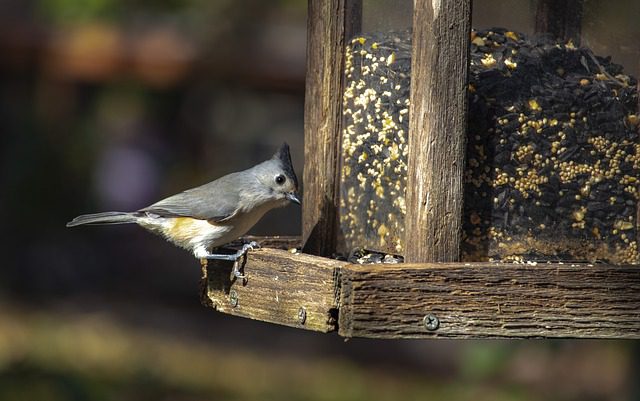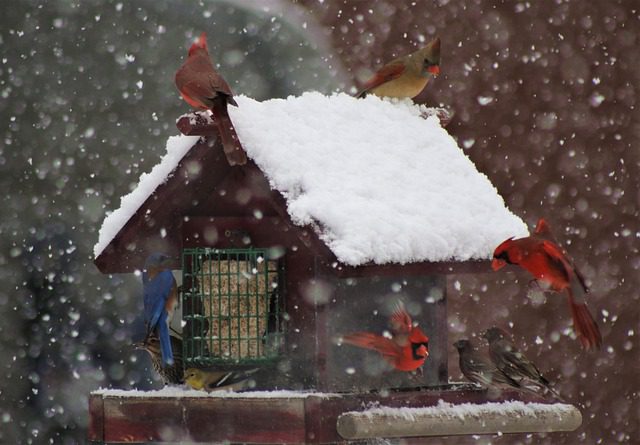
Once upon a time I used to feed the birds during winter. I wanted to help our feathered friends through the lean months until spring finally arrived. I had several feeders, including a tray feeder, a caged feeder (to keep larger birds and those damned squirrels out), and several suet holders that hung from tree branches so that birds whose diet is primarily bugs and small animals would have something to eat.
I try, often unsuccessfully, to garden as naturally as I can. I use herbicides as sparingly as I can, except where bindweed is concerned. I go Agent Orange on that shit. I also refrain from using pesticides, except when wasps make their nests in the shed or by the deck. I’ve been stung too many times by the little bastards to tolerate that kind of behavior.
Attracting birds to the yard is big plus if the gardener is trying to garden naturally. You feed them in the hopes that they’ll stick around and eat all the nasty bugs that can wreck havoc on plants.
They’re also a nice splash of color in dreary winter. And besides, it’s fun to watch their antics.
You will note, however, that I said that I used to feed the birds. While there are a lot of positives to birdfeeding, there are some downsides as well. Downsides that never seem to get addressed in gardening magazine articles or gardening shows.
Let me be clear, I am not attempting to discourage anyone from feeding birds. As I just said, feeding birds is good for the environment, good for the garden and good for the person doing the feeding. So if you are thinking of taking up birdfeeding, I highly encourage you to do so. Just be aware of the following issues.
(Good) birdfeed ain’t cheap:
Those inexpensive wild birdseed bags you can buy in grocery stores and big-box stores are padded with milo, a seed that comes from sorghum. In fact, these cheap birdseed mixes can be up to 60% milo. The problem with milo is that most birds won’t eat it. In fact, the U.S. Fish & Wildlife Service (U.S. Fish & Wildlife Service – Migratory Bird Program | Conserving America’s Birds (fws.gov) points out that there are no bird species in the US that like it.
So for the best results, for you and the birds, spend your money on wild bird mixes that include millet (millet is good!), nyjer, sunflower seeds and cracked corn. It’s more expensive, but if you’re going to feed birds it’s worth it.
Birds are messy eaters, and that’s a problem:
Not all birds eat the same thing. That should be obvious, but it really sinks home when you are feeding the little buggers. If a bird likes a sunflower seeds, for example, it doesn’t hunt and peck through the feeder to find those particular seeds. Nope, they just shove the crap they don’t want out of the way to get to what they do want. So why is that a problem? Because they usually just push the stuff they don’t want over the side of the feeder and onto the ground. And all that seed that hits the ground starts to germinate when the weather warms up in spring.
That’s right, you end up with nice thick carpet of unwanted plants (a.k.a weeds) underneath the feeders; plants that must be grubbed or hoed out of the ground before they get out of control.

You must be consistent:
Birds will come from far and wide once word gets out that there is a ready supply of food available. This means they give up their feeding grounds to make your yard their temporary home. If you feed them and then stop, this can actually do some harm. The birds will linger for awhile to see if the food returns. If it doesn’t, they’ll get hungry and try to get back to their old stomping grounds, which may now be picked over by birds who moved into the area when it was vacated.
Once you start to feed birds, you need to stay with it until warm weather arrives.
It attracts predators and squirrels:
When I mean predators I ain’t talking about cats, although they are a problem as well. No, I’m talking about the feathered kind; hawks, owls, falcon, etc. My worry is not the birds that congregate in the yard. No, my concern is for my dogs! Both of my dogs are small(ish), and I doubt a big ol’ hawk is going to put much effort into distinguishing between pet and pest.
Cats are obviously not a threat to my dogs, but our feline friends kill over a billion wild birds in the United States each year. So if you are going to set out birdfeeders, make sure you leave enough open space around the feeder for birds to keep an eye out for cats. Also, place the feeder near a tree or shrub so the birds have somewhere to flee.
Oh, and putting bells on cats doesn’t do shit. Birds don’t recognize a bell as a threat.
Do birds shit in the garden? Why, yes, yes they do:
Finally, we come to the bird’s bodily function etiquette (or lack there of). The shit everywhere: the deck and deck railings, the patio, the furniture, sidewalks, shed roofs, hell, they crap on the feeding stations themselves! Which means dragging out the hose to wash it all off, even in winter. Well, unless you don’t mind walking in bird crap.
So if you want to feed our feathered friends, by all means do so. I highly encourage it. But now you are aware of the pitfalls of doing so.

